In all major asset classes, Bitcoin has the highest correlation with global liquidity.
Author: Sam Callahan
Translation: Luffy, Foresight News
Abstract
- In any given 12-month period, Bitcoin's direction is consistent with global liquidity 83% of the time, a rate higher than any other major asset class, making Bitcoin a barometer of liquidity.
- While Bitcoin has a high correlation with global liquidity, it is not immune to short-term deviations caused by special events or internal market dynamics.
- Combining the global liquidity situation with Bitcoin on-chain valuation indicators can provide a more detailed understanding of Bitcoin cycles, helping investors identify internal market dynamics that may decouple Bitcoin from global liquidity trends.
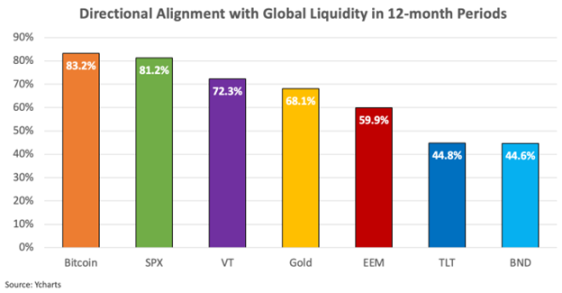
Correlation of major asset classes with global liquidity
Background
Understanding how asset prices change with changes in global liquidity has become crucial for investors looking to increase returns and effectively manage risks. In today's market, asset prices are increasingly influenced by central bank policies directly affecting liquidity conditions. Fundamentals are no longer the primary driver of asset prices.
This phenomenon has become increasingly apparent since the global financial crisis. Since then, these unconventional monetary policies have increasingly become the dominant force driving asset prices. Central bank governors have turned the market into a big trade using liquidity leverage, as economist Mohamed El-Erian put it, central banks have become the "only game in town."
Stanley Druckenmiller has expressed a similar view, saying, "Earnings don't move the overall market; it's the Federal Reserve… focus on the central banks and focus on the movement of liquidity… most people in the market are looking for earnings and conventional measures. It's liquidity that moves markets."
This is particularly evident in the S&P 500 index.
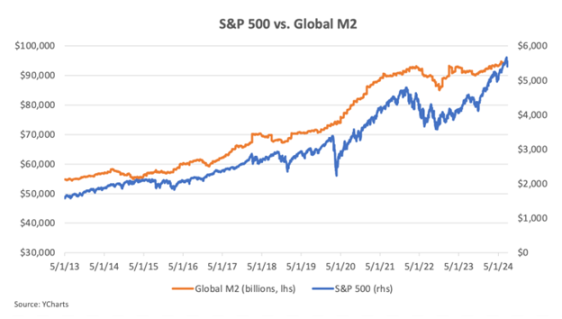
Comparison of the S&P 500 index with global M2 trends
The correlation in the above figure can be attributed to a simple supply and demand relationship. If more funds are available to purchase something, whether it's stocks, bonds, gold, or Bitcoin, the prices of these assets generally rise. Since 2008, central banks around the world have injected more fiat currency into the financial system, and asset prices have responded accordingly. In other words, monetary inflation has fueled asset price inflation.
In this context, investors must understand how to measure global liquidity and how different assets respond to changes in liquidity conditions in order to better navigate these liquidity-driven markets.
Measuring Global Liquidity
There are many ways to measure global liquidity. In this report, we will use global M2: a broad measure of money supply that includes physical currency, checking accounts, savings deposits, money market securities, and other forms of easily accessible cash.
Bitcoin Magazine Pro provides a measure of global M2 that aggregates data from the eight largest economies: the United States, China, the Eurozone, the United Kingdom, Japan, Canada, Russia, and Australia. It is a good indicator of global liquidity as it reflects the total funds available for spending, investing, and borrowing on a global scale. Another way to think about it is as a measure of the total amount of credit creation and central bank money printing in the global economy.
A subtle difference here is that global M2 is priced in US dollars. Lyn Alden explained in a previous article why this is important:
The importance of pricing in dollars is that the dollar is the global reserve currency, and thus the primary unit of account for global trade, contracts, and debts. When the dollar strengthens, debts around the world become harder. When the dollar weakens, debts around the world become easier. A dollar-priced global broad money supply is like a key metric for measuring global liquidity. How fast are fiat currency units being created, and how strong is the dollar relative to other currency markets globally.
When global M2 is priced in US dollars, it reflects both the relative strength of the dollar and the speed of credit creation, making it a reliable indicator of global liquidity conditions.
Why Bitcoin Might Be the Purest Barometer of Liquidity
Over the years, there has been a strong correlation between one asset and global liquidity, and that is Bitcoin. As global liquidity expands, Bitcoin tends to thrive. Conversely, when liquidity contracts, Bitcoin is also affected. This phenomenon has led some to refer to Bitcoin as a "barometer of liquidity."
The following figure clearly shows how the price of Bitcoin tracks changes in global liquidity.
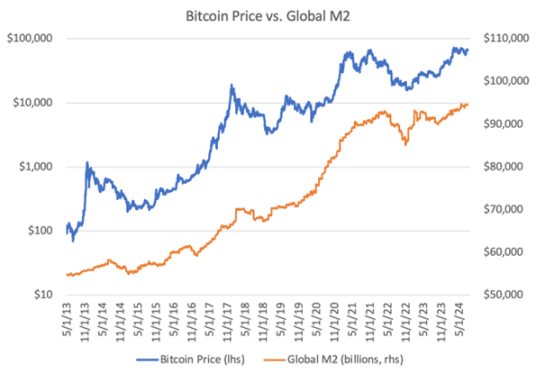
Similarly, comparing the year-on-year percentage changes of Bitcoin and global liquidity also highlights the synchronicity of their changes, with Bitcoin's price rising when liquidity increases and falling when liquidity decreases.
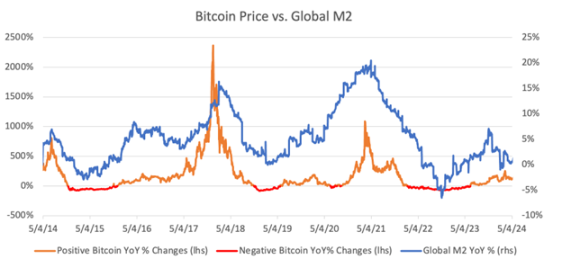
From the above figure, it can be seen that the price of Bitcoin is highly sensitive to changes in global liquidity. But is it the most sensitive asset in today's market?
In general, risk assets have a higher correlation with liquidity conditions. In environments with good liquidity, investors tend to adopt risk-seeking strategies, moving capital to assets with higher risk/return. Conversely, when liquidity tightens, investors typically move capital to what they perceive as safer assets. This explains why assets such as stocks tend to perform well in periods of increased liquidity.
However, stock prices are also influenced by factors outside of liquidity conditions. For example, stock performance is partly driven by earnings and dividends. This may weaken the correlation between stocks and global liquidity.
Additionally, the US stock market benefits from structural inflows of passive funds through retirement accounts such as 401(k)s, which can buffer the US stock market from fluctuations in liquidity conditions, potentially reducing its sensitivity to global liquidity conditions.
The relationship between gold and liquidity is more complex. On one hand, gold benefits from increased liquidity and a weaker dollar, but on the other hand, gold is also seen as a safe-haven asset. In periods of liquidity contraction and risk aversion, investors seek safety, and demand for gold may increase. This means that even in times of reduced liquidity, the price of gold can perform well. Therefore, the performance of gold may not be as closely related to liquidity conditions as other assets.
Like gold, bonds are also considered safe-haven assets, so their correlation with liquidity conditions may be lower.
Finally, we come back to Bitcoin. Unlike stocks, Bitcoin has no earnings or dividends, and there are no structural purchases that affect its performance. At this stage of the Bitcoin adoption cycle, most capital pools still view it as a risk asset relative to other assets. Compared to other assets, Bitcoin has the purest correlation with global liquidity.
If this is indeed the case, it is a valuable conclusion for both Bitcoin investors and traders. For long-term holders, understanding the correlation between Bitcoin and liquidity can provide a deeper understanding of the driving factors behind its price changes over time. For traders, Bitcoin provides a tool to express views on the future direction of global liquidity.
This article aims to delve into the correlation between Bitcoin and global liquidity, compare it with other asset classes, identify periods of correlation breakdown, and share how investors can profit from this information in the future.
Quantifying the Correlation Between Bitcoin and Global Liquidity
When analyzing the correlation between Bitcoin and global liquidity, it is important to consider both the magnitude and direction of the correlation.
The magnitude of the correlation indicates the degree of association between two variables. A higher correlation indicates that changes in global M2 have a more predictable impact on the price of Bitcoin. Understanding this degree of association is crucial in measuring the sensitivity of Bitcoin to changes in global liquidity.
Based on data from May 2013 to July 2024, the strong sensitivity of Bitcoin to liquidity is evident. During this period, the correlation between the price of Bitcoin and global liquidity is 0.94, reflecting a very strong positive correlation. This indicates that the price of Bitcoin is highly sensitive to changes in global liquidity during this time frame.
Looking at the 12-month rolling correlation, the average correlation between Bitcoin and global liquidity decreases to 0.51. This is still a positive correlation, but significantly lower than the overall correlation.
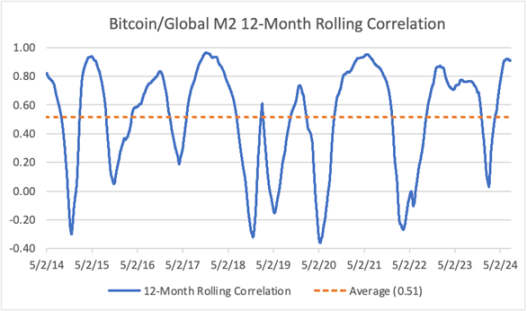
Furthermore, when examining the 6-month rolling correlation, the correlation further decreases to 0.36.
This suggests that as the time frame shortens, the price of Bitcoin deviates more from its long-term liquidity trend, indicating that short-term price movements are more likely to be influenced by internal factors specific to Bitcoin rather than liquidity conditions.
To better understand the correlation between Bitcoin and global liquidity, we compared it with other assets, including the SPDR S&P 500 ETF (SPX), Vanguard Total World Stock ETF (VT), iShares MSCI Emerging Markets ETF (EEM), iShares 20+ Year Treasury Bond ETF (TLT), Vanguard Total Bond Market ETF (BND), and gold.
In terms of the 12-month rolling correlation, Bitcoin has the highest correlation, followed closely by gold, then stock indices, with bond indices showing the weakest correlation with liquidity.
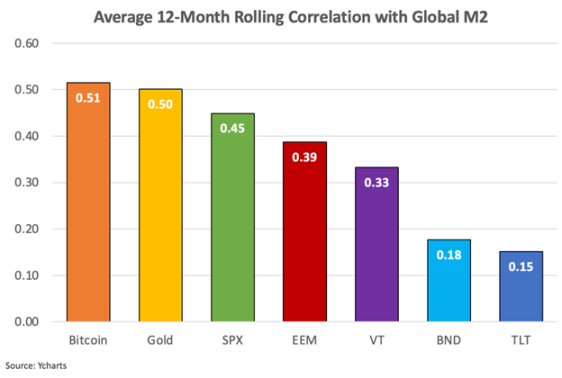
When analyzing the correlation between assets and global liquidity based on year-on-year percentage changes, stock indices exhibit slightly stronger correlation than Bitcoin, followed by gold and bonds.
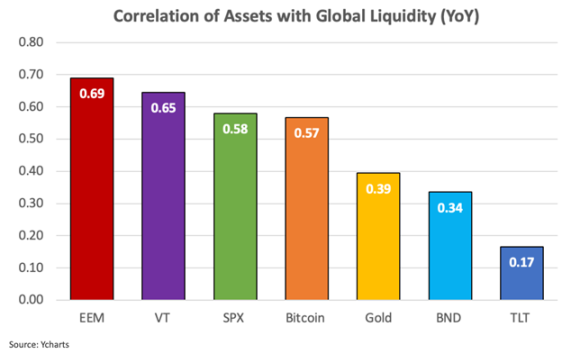
In terms of year-on-year percentage changes, stock indices may have a higher correlation with global liquidity than Bitcoin, partly due to the high volatility of Bitcoin. The price of Bitcoin tends to fluctuate significantly within a year, which may distort its correlation with global liquidity. In contrast, the price fluctuations of stock indices are usually less pronounced and closer to the year-on-year percentage changes in global M2. Nevertheless, the correlation between Bitcoin and global liquidity based on year-on-year percentage changes remains quite strong.
The above data highlights three key points: 1) the performance of stocks, gold, and Bitcoin is closely related to global liquidity; 2) compared to other asset classes, Bitcoin has a strong overall correlation, with the highest correlation in the 12-month rolling period; 3) as the time frame shortens, the correlation between Bitcoin and global liquidity weakens.
Bitcoin's Consistent Alignment with Liquidity Sets It Apart
As mentioned earlier, a strong positive correlation does not guarantee that two variables will always move in the same direction over time. This is especially true when an asset (such as Bitcoin) has high volatility and may temporarily deviate from the long-term correlation with a less volatile indicator (such as global M2). This is why combining these two aspects (magnitude and direction) can provide a more comprehensive understanding of how Bitcoin and global M2 interact over time.
By considering the consistency of the direction of the correlation, we can better understand the reliability of their correlation, especially for those interested in long-term trends. If you know that Bitcoin tends to track the direction of global liquidity most of the time, you can have more confidence in predicting the future price direction of Bitcoin based on changes in liquidity conditions. Among all the analyzed assets, Bitcoin has the highest correlation with the direction of global liquidity.

The following figure further illustrates the consistent alignment of Bitcoin with global liquidity over the 12-month rolling period compared to other asset classes.
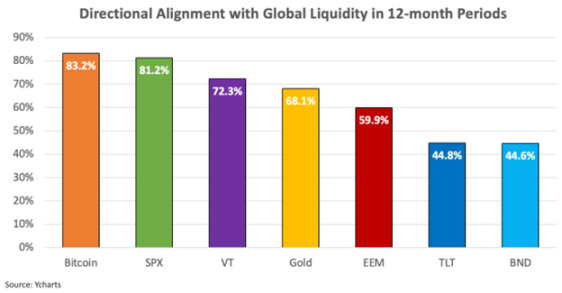
This indicates that while the strength of the correlation may vary with the time frame, the price of Bitcoin typically aligns with the direction of global liquidity. Furthermore, its price alignment is closer to global liquidity than any other traditional asset analyzed.
The relationship between Bitcoin and global liquidity is not only strong in magnitude but also consistent in direction. The data further confirms the view that Bitcoin is more sensitive to liquidity conditions than other traditional assets, especially over longer time frames.
For investors, this means that global liquidity may be a key driver of Bitcoin's long-term price performance, and this factor should be considered when evaluating Bitcoin market cycles and predicting future price trends. For traders, it means that Bitcoin provides a highly sensitive investment tool to reflect views on global liquidity, making it the preferred reference for those with strong beliefs in liquidity.
Shortcomings of Bitcoin's Liquidity Correlation
Although Bitcoin has an overall strong correlation with global liquidity, research results indicate that in shorter rolling periods, the price of Bitcoin often deviates from liquidity trends. These deviations may be due to internal market dynamics having a greater impact on Bitcoin's price during certain moments in the Bitcoin market cycle than changes in global liquidity conditions, or they may be due to specific events unique to the Bitcoin industry.
Special events refer to events within the cryptocurrency industry that can lead to rapid shifts in market sentiment or trigger large-scale liquidation. For example, the collapse of major companies, exchange hacks, regulatory crackdowns, or the unraveling of Ponzi schemes.
Looking back at instances where the 12-month rolling correlation between Bitcoin and global liquidity weakened, it is clear that the price of Bitcoin often decouples from liquidity trends during significant industry events.
The following figure illustrates the decoupling of Bitcoin from liquidity during major industry events.
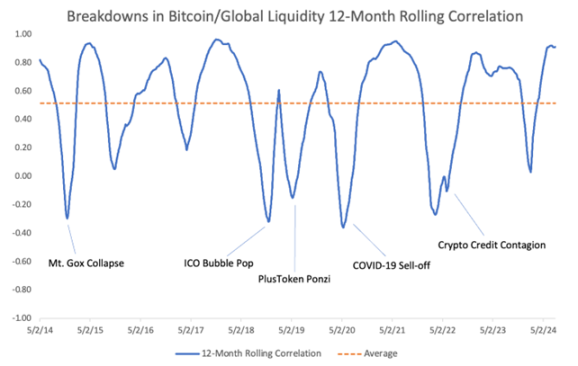
Panic and selling pressure triggered by key events such as the collapse of Mt. Gox, the collapse of the PlusToken Ponzi scheme, and the cryptocurrency trust crisis caused by the collapse of Terra/Luna are largely disconnected from global liquidity trends.
The market crash due to COVID-19 in 2020 is another example. In the widespread panic selling and risk aversion, Bitcoin initially experienced a significant decline. However, as central banks injected unprecedented liquidity as a response, Bitcoin quickly rebounded, highlighting its sensitivity to changes in liquidity. The decoupling of correlation at that time can be attributed to a sudden shift in market sentiment rather than changes in liquidity conditions.
While understanding the impact of these special events on the correlation between Bitcoin and global liquidity is important, their unpredictability makes it difficult for investors to take action. Nevertheless, as the Bitcoin ecosystem matures, infrastructure improves, and regulations become clearer, I expect the frequency of these "black swan" events to decrease over time.
How Supply-Side Factors Affect Bitcoin's Liquidity Correlation
In addition to special events, another notable phenomenon during periods of weakened correlation between Bitcoin and liquidity is that these situations often coincide with sharp declines in the price of Bitcoin following extreme valuations. This was evident during the peak of the bull markets in 2013, 2017, and 2021, when the correlation between Bitcoin and liquidity decoupled as its price sharply dropped from high levels.
While liquidity primarily affects the demand side of the equation, understanding the distribution patterns of the supply side also helps identify periods when Bitcoin may deviate from its long-term correlation with global liquidity.
The primary source of supply comes from old holders who profit as the price of Bitcoin rises. The new issuance of block rewards also contributes to the supply in the market, but to a much lesser extent, and it continues to decrease with each halving event. During bull markets, old holders typically reduce their positions and sell to new buyers until the demand saturates. This saturation point is often the peak of the bull market.
A key indicator to assess this behavior is the Bitcoin held for over 1 year volatility, which measures the percentage of total circulating supply held by long-term holders (at least one year) at any given time.
Historically, this indicator decreases during bull markets as long-term holders sell off, and increases during bear markets as long-term holders accumulate. The following figure illustrates this behavior, with red circles indicating peak periods and green circles indicating bottoms.
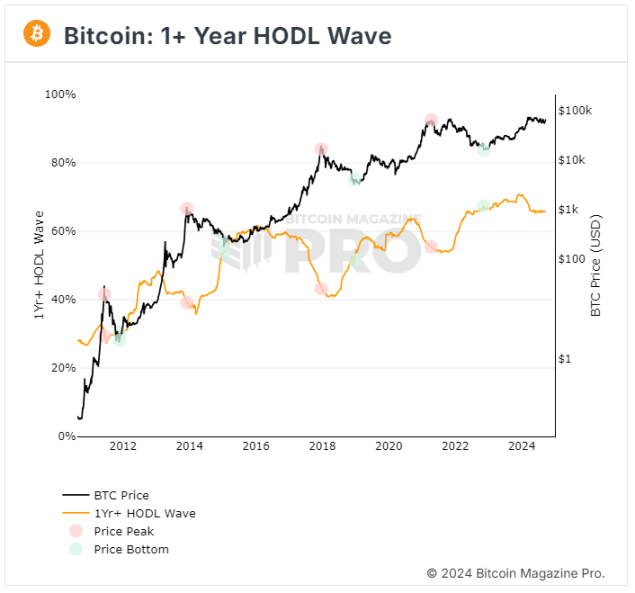
This illustrates the behavior of long-term holders in the Bitcoin cycle. When Bitcoin appears to be overvalued, long-term holders often sell for profit, and when Bitcoin appears to be undervalued, they often accumulate.
The question then becomes, "How do you determine when Bitcoin is overvalued or undervalued in order to better predict when the supply will flood the market or be exhausted?"
Although the dataset is still relatively small, the Market Value to Realized Value Z-Score (MVRV Z-Score) has been proven to be a reliable tool for identifying when Bitcoin reaches extreme valuation levels. The MVRV Z-Score is based on three components:
1) Market Value: The current market capitalization, calculated by multiplying the price of Bitcoin by the total circulating supply of Bitcoin.
2) Realized Value: The average price at which each Bitcoin or UTXO last transacted on-chain multiplied by the total circulating supply—essentially the cost basis of Bitcoin holders.
3) Z-Score: This score measures the degree of deviation between market value and realized value, expressed in standard deviations, and highlights periods of extreme overvaluation or undervaluation.
When the MVRV Z-Score is high, it indicates a significant gap between market price and realized price, meaning many holders are sitting on unrealized profits. This is intuitively a good thing, but it may also indicate that Bitcoin is overbought or overvalued, presenting a good opportunity for long-term holders to sell and profit.
When the MVRV Z-Score is low, it indicates that the market price is close to or below the realized price, suggesting that Bitcoin is oversold or undervalued, presenting a good opportunity for investors to start accumulating.
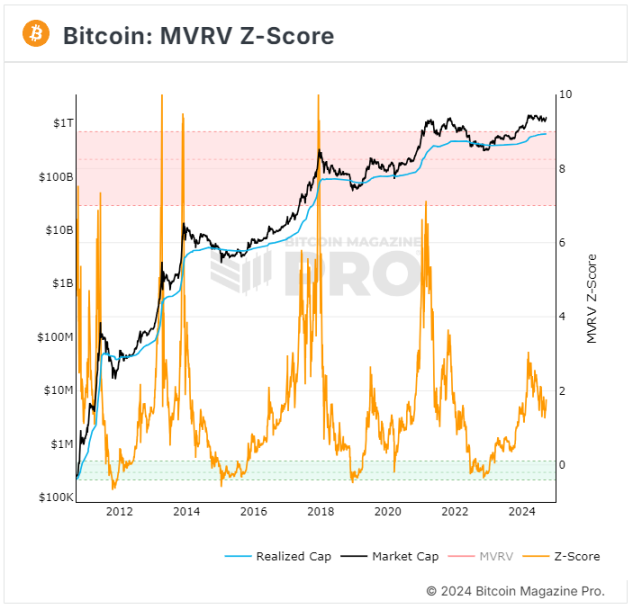
When the MVRV Z-Score is overlaid with the 12-month rolling correlation between Bitcoin and global liquidity, a pattern begins to emerge. When the MVRV Z-Score sharply declines from historical highs, the 12-month rolling correlation seems to become ineffective. The red rectangles represent these periods.
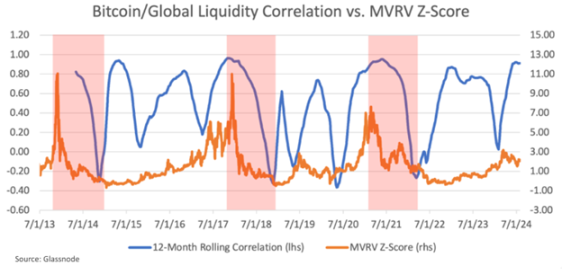
This indicates that when Bitcoin's MVRV Z-Score starts to decline from highs and the correlation with liquidity becomes ineffective, internal market dynamics (such as profit-taking and panic selling) may have a greater impact on the price of Bitcoin than global liquidity conditions.
At extreme valuation levels, the price of Bitcoin tends to be more influenced by market sentiment and supply dynamics rather than trends in global liquidity. This finding is valuable for traders and investors, as it can help identify periods when Bitcoin deviates from its long-term correlation with global liquidity.
For example, suppose a trader strongly believes that the US dollar will decline, and global liquidity will increase over the next year. Based on this analysis, Bitcoin would be the best tool to prove their point, as it is the purest barometer of liquidity in today's market.
However, traders should first assess the MVRV Z-Score of Bitcoin or similar valuation indicators before making trades. If the MVRV Z-Score of Bitcoin indicates overvaluation, traders should remain cautious even in a good liquidity environment, as internal market dynamics may surpass liquidity conditions and drive price adjustments.
By monitoring the long-term correlation between Bitcoin and global liquidity, as well as the MVRV Z-Score, investors and traders can better predict how the price of Bitcoin will respond to changes in liquidity conditions. This approach enables market participants to make wiser decisions and potentially increase their success rate in investing or trading Bitcoin.
Conclusion
The strong correlation between Bitcoin and global liquidity makes it a macroeconomic barometer for investors and traders. Compared to other asset classes, Bitcoin not only has a strong correlation with global liquidity but also the highest level of consistency in direction. One can view Bitcoin as a mirror reflecting the speed of global currency creation and the relative strength of the US dollar. Unlike stocks, gold, or bonds, the correlation between Bitcoin and liquidity is the purest.
However, Bitcoin's correlation is not perfect. Research indicates that the strength of Bitcoin's correlation decreases in the short term, highlighting the importance of identifying periods when Bitcoin's correlation with liquidity breaks down.
Internal market dynamics in Bitcoin, such as special events or extreme valuation levels, may cause it to temporarily deviate from the influence of global liquidity. These times are crucial for investors as they often signal price adjustments or accumulation periods. Combining the analysis of global liquidity with on-chain indicators (such as the MVRV Z-Score) can provide a better understanding of Bitcoin's price cycles and help determine when its price may be more driven by sentiment rather than liquidity trends.
Michael Saylor once said, "All your models are broken." Bitcoin represents a paradigm shift in money itself. Therefore, no statistical model can perfectly capture the complexity of the Bitcoin phenomenon, but some models can be useful tools for guiding decisions. As the old saying goes, "All models are wrong, but some models are useful."
Since the global financial crisis, central banks have distorted financial markets through unconventional policies, making liquidity the primary driver of asset prices. Therefore, understanding changes in global liquidity is crucial for any investor hoping to successfully navigate today's markets. Macro analyst Luke Gromen has described Bitcoin as the "last fully functional smoke alarm" because it can signal changes in liquidity conditions.
When the alarm sounds for Bitcoin, investors should listen wisely to manage risks and devise strategies to fully capitalize on future market opportunities.
免责声明:本文章仅代表作者个人观点,不代表本平台的立场和观点。本文章仅供信息分享,不构成对任何人的任何投资建议。用户与作者之间的任何争议,与本平台无关。如网页中刊载的文章或图片涉及侵权,请提供相关的权利证明和身份证明发送邮件到support@aicoin.com,本平台相关工作人员将会进行核查。




